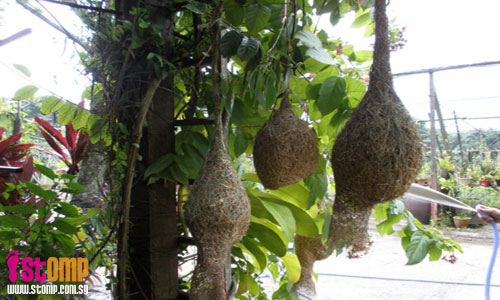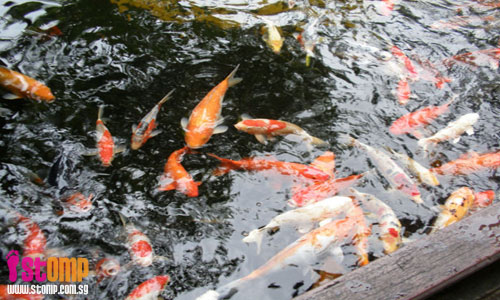
STOMPer Ornithologist went to the fish farm at Lim Chu Kang and saw several weaver bird nests and a school of Japanese carp.
Sharing his findings, he says:
"These pictures were taken at a fish farm at Lim Chu Kang Lane 6.
"At the entrance of the farm I noticed several weaver bird nests on a tree.
"The weaver birds are gregarious birds which breed colonially. The birds build their nests together, and usually the male birds weave the nests and use them as a form of display to lure the females.
"I also saw a school of kois in a pond. The koi is also known as the Japanese carp.
"Kois have no stomachs. What they do have are expandable small intestines and they function as a pseudo stomach.
"They have small teeth in the back of the throat that they use to crush any crustaceans they may ingest.
"Kois are 'pigs' of the water because they love and eat anything they can find. They can consume up to 2% of its body in a day."


More nests of the baya weaver (Ploceus philippinus), I see. I wonder if they are still in use.
I was surprised to learn that common carp (Cyprinus carpio) actually lack a proper stomach. Instead, the oesophagus opens up into the lower intestine.
According to this link on digestion in teleost fishes:
Carp lack a stomach, but have a long intestine which winds extensively throughout the visceral cavity. The gall bladder rests on the dorsal surface of the anterior midgut and the bile duet opens into the intestine just anterior to the gall bladder. In addition, the liver has no specific shape, but seems to serve as packing material around the intestine. Food seems to be ingested in small particles in a relatively steady stream instead of intermittently in large units, so the storage function of a stomach probably is not missed. With the liver filling all the available visceral space, there would be no room for accommodating the stomach expansion of a large meal anyway.
By the way, koi is both singular and plural. There is no such word as 'kois'.